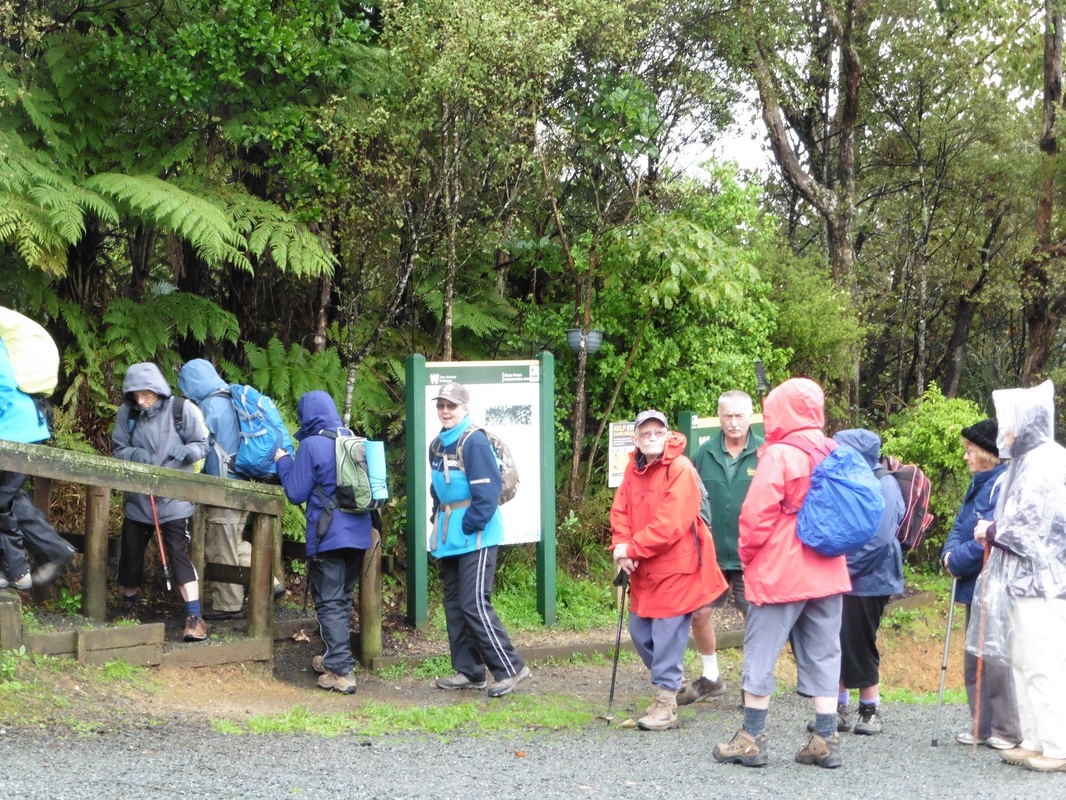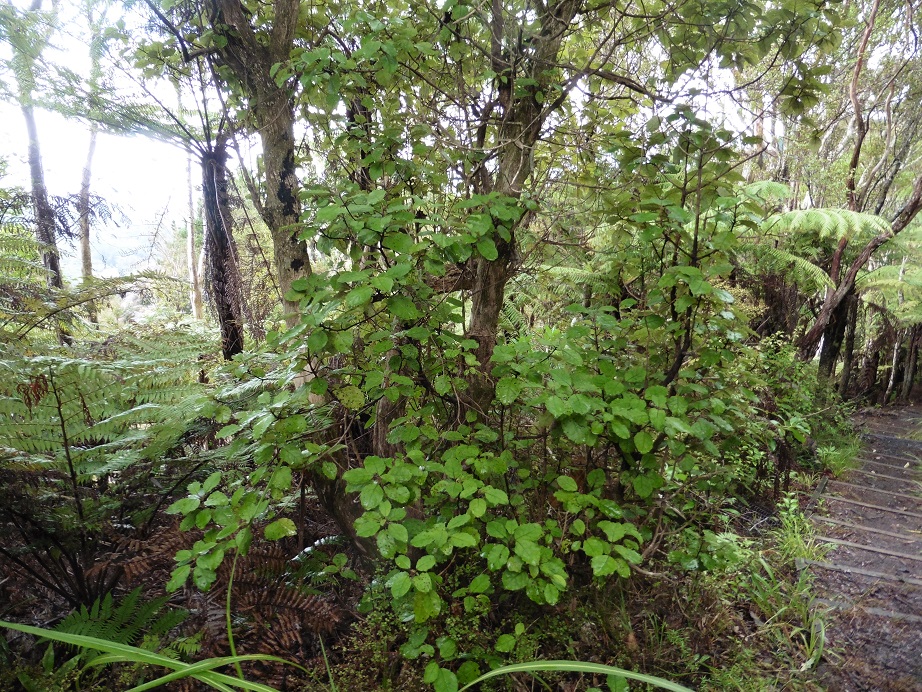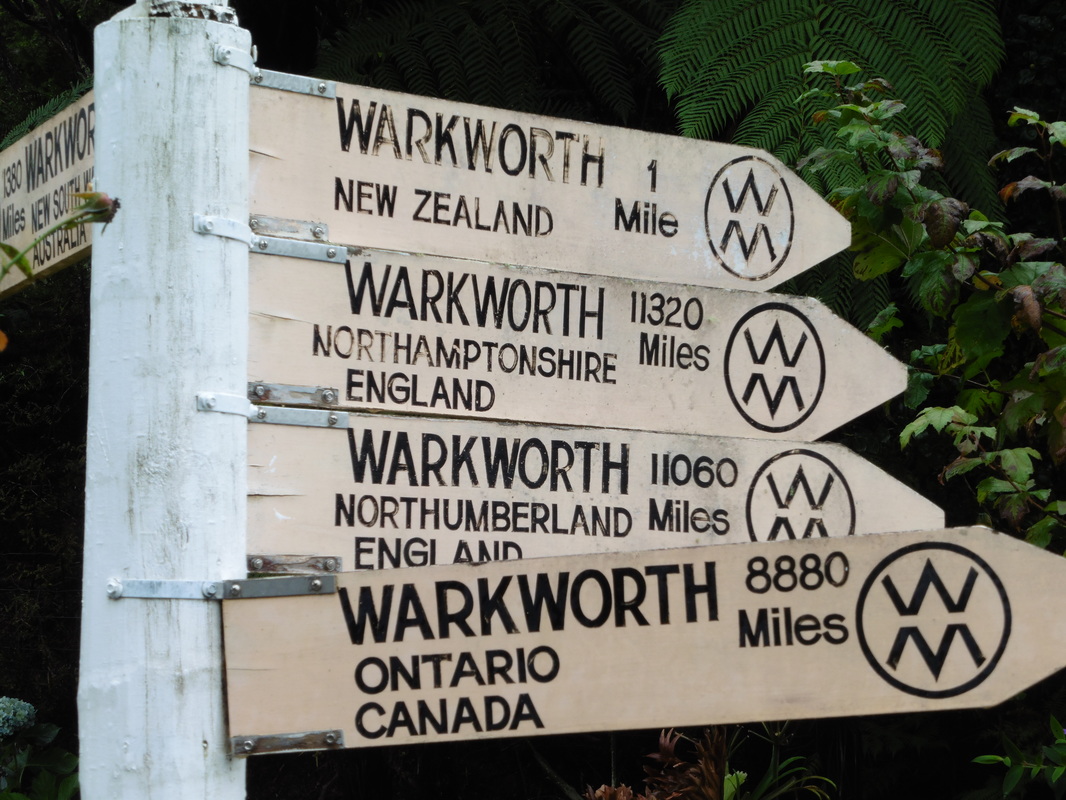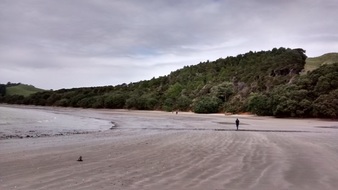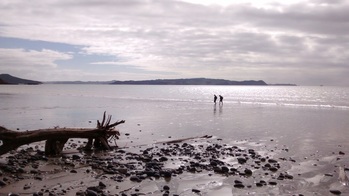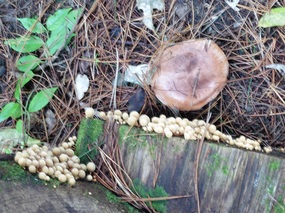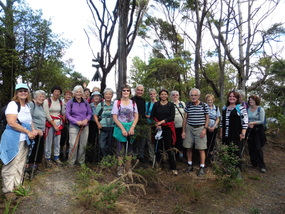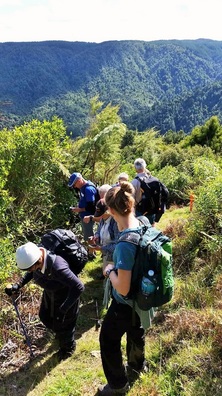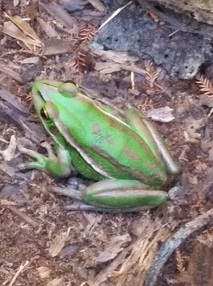Trip Reports, April - May 2015
The Dome and Warkworth
31 May 2015
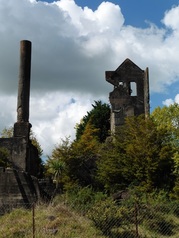 Part of the cement works ruins.
Part of the cement works ruins.
Thirty of us headed up "just a few" steps lol..to
the Dome Lookout..several of us being greeted by a resident tomtit resplendent
in his sharp black and white Sunday best. We were thrilled by Nature's
"rainy day special"..the shimmering webs of the Sheet web spider..the
refreshed fungi..and the kaleidoscope of greens contrasting beautifully with
the keen bronze of the fallen kauri twigs. A view of the Warkworth area was even
available despite the rain.
Down again to the Dome Cafe for hot drinks and tasty goodies before we bussed to Wilson Cement Works where an accidental dynamite explosion (not the day we were there) had sent a huge wagon wheel soaring skywards only to plunge down through the site manager's roof at Wilson House. We learnt that the cement works were closed in 1929 and are now a Historic Places site. We wandered around the swim hole, spectacular ruins and boat yard before bussing to Warkworth Museum.
After lunching there under cover, the adjacent and amazingly beautiful Parry Kauri Park was ripe for a quiet meander. We listened to rain drops bouncing onto leaves, wee waterfalls and a fluster of excited bird chatter as the first sunshine of the day peeked through the tree tops. We discussed matai and miro.....thanks Des..and happily shared our knowledge and 'lack of'... providing lots of friendly laughter for everyone. Some found the contrast of the irregular and twisted supporting branches of the taraire against the underside of its leafy canopy..captivating.
To top off our day we visited the museum ..where one of the fellas bought a very nice fuchsia and at least a few of us gals bought very nice ice creams. The Warkworth Museum requires that one explore..there are rooms off rooms and passages off passages all packed and well documented with very well-displayed items pertaining to Warkworth and of course to the particular areas we had just visited. www.warkworthmuseum.co.nz
Big thanks to Bev and Lynne for organising a great day.
Down again to the Dome Cafe for hot drinks and tasty goodies before we bussed to Wilson Cement Works where an accidental dynamite explosion (not the day we were there) had sent a huge wagon wheel soaring skywards only to plunge down through the site manager's roof at Wilson House. We learnt that the cement works were closed in 1929 and are now a Historic Places site. We wandered around the swim hole, spectacular ruins and boat yard before bussing to Warkworth Museum.
After lunching there under cover, the adjacent and amazingly beautiful Parry Kauri Park was ripe for a quiet meander. We listened to rain drops bouncing onto leaves, wee waterfalls and a fluster of excited bird chatter as the first sunshine of the day peeked through the tree tops. We discussed matai and miro.....thanks Des..and happily shared our knowledge and 'lack of'... providing lots of friendly laughter for everyone. Some found the contrast of the irregular and twisted supporting branches of the taraire against the underside of its leafy canopy..captivating.
To top off our day we visited the museum ..where one of the fellas bought a very nice fuchsia and at least a few of us gals bought very nice ice creams. The Warkworth Museum requires that one explore..there are rooms off rooms and passages off passages all packed and well documented with very well-displayed items pertaining to Warkworth and of course to the particular areas we had just visited. www.warkworthmuseum.co.nz
Big thanks to Bev and Lynne for organising a great day.
Tawhitokino Regional Park
17 May 2015
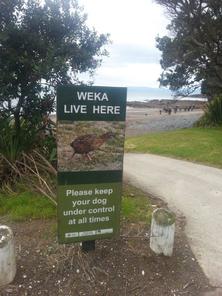
A large group of thirty-seven enthusiastic walkers enjoyed a wonderful outing at Tawhitokino Beach.
After a short stop at Clevedon markets we carried on by bus to Kawakawa Bay. Our group walked along the road that was built during the depression with pick and shovel to Waiti Bay. After clambering over the rocks a low tide we climbed numerous steps through native bush to the top of the hill and down the other side to the secluded beach of Tawhitokino. This park is part of Te Ara Moana "the sea-going pathway" and the campground at the far end of the beach is used by kayakers travelling this ancient pathway. Offshore you can see Coromandel and Ponui Island.
There are eleven weka sites monitored by Forest and Bird in the area. Traps for rats are baited every four weeks with unwashed eggs, freeze-dried rabbit and peanut butter. In total there are 160 traps which are specially designed to be weka-safe - they are much longer than normal traps.
The surrounding cliffs and rocks are greywacke and chert. At each end of the beach and at Waiti Bay there are rock pools with plenty of sea life to explore.
After a good stretch of everyone's legs on the road back to the bus, we all headed back to Auckland a lot more knowledgeable about the area.
Thank you to Hannah and Elane for leading this walk.
After a short stop at Clevedon markets we carried on by bus to Kawakawa Bay. Our group walked along the road that was built during the depression with pick and shovel to Waiti Bay. After clambering over the rocks a low tide we climbed numerous steps through native bush to the top of the hill and down the other side to the secluded beach of Tawhitokino. This park is part of Te Ara Moana "the sea-going pathway" and the campground at the far end of the beach is used by kayakers travelling this ancient pathway. Offshore you can see Coromandel and Ponui Island.
There are eleven weka sites monitored by Forest and Bird in the area. Traps for rats are baited every four weeks with unwashed eggs, freeze-dried rabbit and peanut butter. In total there are 160 traps which are specially designed to be weka-safe - they are much longer than normal traps.
The surrounding cliffs and rocks are greywacke and chert. At each end of the beach and at Waiti Bay there are rock pools with plenty of sea life to explore.
After a good stretch of everyone's legs on the road back to the bus, we all headed back to Auckland a lot more knowledgeable about the area.
Thank you to Hannah and Elane for leading this walk.
Albany walks
03 May 2015
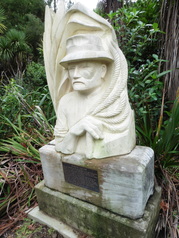 Pioneer Daniel Lucas
Pioneer Daniel Lucas
Thirty ANHC walkers, including two guests, passed an enjoyable autumn day exploring three very different
parks in the immediate Albany vicinity. The first one involved the connecting
areas of Kells Park, the Landing and Lucas Creek. Margaret Bol enlightened the
group regarding pioneer Daniel Lucas who helped establish the flax exporting industry
in the 1840s, and of apple and pear orchards developed later in the 1880s, with
Britain the intended market.
The Three Streams Reserve just north of Albany was the location for our second walk, where we marveled at the work of John Hogan as its past custodian, an enthusiastic conservationist who with volunteers, planted 600 Kauris seedlings in 1984. Club members tried their hand at fern spotting with valued member Brian Cumber’s expert knowledge and Margaret’s handy identification sheet. From here we travelled via the very scenic Albany Heights Road taking in spectacular views of Auckland city.
Our final walk for the day included the Gills Scenic Reserve, which passed a charming waterfall that marks the upper reaches of the tidal Lucas Creek. We followed the main loop and were rewarded with very large coastal broadleaf trees such as puriri and an outstanding picturesque Nikau grove. Here the bird life thrives with the sound of grey warblers and tui ever present. An excellent day with perfect weather for hiking, three delightful walks and great camaraderie.
Thank you to Margaret and Elizabeth for organising this day.
The Three Streams Reserve just north of Albany was the location for our second walk, where we marveled at the work of John Hogan as its past custodian, an enthusiastic conservationist who with volunteers, planted 600 Kauris seedlings in 1984. Club members tried their hand at fern spotting with valued member Brian Cumber’s expert knowledge and Margaret’s handy identification sheet. From here we travelled via the very scenic Albany Heights Road taking in spectacular views of Auckland city.
Our final walk for the day included the Gills Scenic Reserve, which passed a charming waterfall that marks the upper reaches of the tidal Lucas Creek. We followed the main loop and were rewarded with very large coastal broadleaf trees such as puriri and an outstanding picturesque Nikau grove. Here the bird life thrives with the sound of grey warblers and tui ever present. An excellent day with perfect weather for hiking, three delightful walks and great camaraderie.
Thank you to Margaret and Elizabeth for organising this day.
Hunua Ranges
19 April 2015
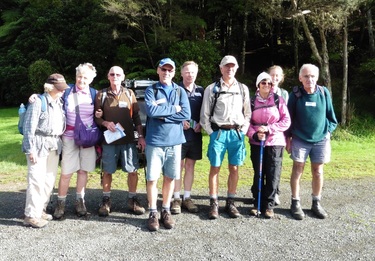 The "fit and fast" group who did the full Mangatawhiri loop walk.
The "fit and fast" group who did the full Mangatawhiri loop walk.
After a day of very heavy rain on Saturday, we were all very relieved to see Sunday dawn and the rain had stopped. We were off to walk in the Hunuas, prepared to get pretty muddy and up for the challenge.
The Hunua Ranges contain the largest native forest in the Auckland region, covering about 400 square kilometres. The ranges are home to the Hunua Falls and four dams, Cosseys, Wairoa, Mangatawhiri and Mangatangi, supplying much of Auckland's water supply.
The plan was for the "fittest and fastest" of us to walk the six hour loop track around the Mangatawhiri Reservoir, and those wanting a shorter walk would go partway up Ernies Track then return the same way. A few others opted to explore the dam area and do some botanising. We set off up Waterline Road then turned in to begin Ernies Track and tackle the muddy bits, the stream crossings and the ups and downs.
The nine who did the full six hour loop were rewarded with magnificent views and a sighting of the amazing kokako, such a rare and unexpected treat. To hear the haunting call of the kokako is magic in itself, to see it is something you never forget. Also spotted were a green and golden bell frog, (an Australian import), the New Zealand Passion Vine, kohia, with its bright orange fruit, both orange and red rata in flower and a friendly little male tomtit. A great payback for doing the challenging loop. After Piggots camp it was on down the Lilburne Track and back to the bus where the "fit 9" were surprised with "well done" certificates and welcomed back by the 24 others who had enjoyed the shorter walk.
Thanks to Derek, Donald, Janet and Gail for this great day.
